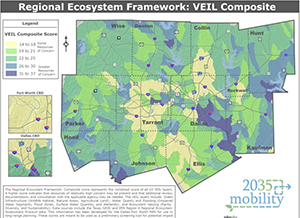North Central Texas Regional Ecosystem Framework

Vital Ecosystem Information Layer (VEIL) composite scores for the Dallas-Fort Worth Region. (Courtesy of
NCTCOG)
North Central Texas Council of Governments
Project Goals
The goals of the North Central Texas Council of Governments (NCTCOG) Eco-Logical project were to develop an REF (see footnote on page 28) to help agencies assess environmental impacts of proposed infrastructure projects and to enhance multi-agency understanding of critical resource-protection areas. To develop the REF, NCTCOG analyzed and aggregated GIS data developed by EPA Region 6 (see project summary on page 42) to the subwatershed level for the entire Metropolitan Planning Area.
Project Activities and Accomplishments
NCTCOG utilized a watershed-scale approach to integrate regional conservation data and infrastructure planning into an REF dataset. Specifically, NCTCOG used the regional data to develop ten base maps and one composite map of resource priorities by watershed. The project team developed an REF user guide to introduce the public to the watershed concept and a technical overview document to help other COGs replicate the process. The guide focuses primarily on watershed information with some guidance on applications for transportation infrastructure. The team collected feedback from regional resource agencies, including the U.S. Environmental Protection Agency, the U.S. Fish and Wildlife Service, and Texas Parks and Wildlife, to refine the priority weightings assigned to different criteria in the REF methodology. NCTCOG also solicited feedback from the resource agencies in vetting the environmental policies included in the Metropolitan Transportation Plan (MTP). The MTP adopted in 2011 was the first to include a chapter devoted to environmental considerations, which was possible due to the analysis and data contained in the REF.
Future Steps
NCTCOG plans to use the REF as a decisionmaking tool in the next iteration of the MTP to inform project selection, evaluate sustainability measures, and improve regional mitigation initiatives. NCTCOG also plans to develop a regional mitigation framework, or “Shared Value Mitigation Program,” which will enhance the implementation of the REF. Through this program transportation agencies will fund priority resource mitigation initiatives defined by resource agencies in their multi-year strategic plans. Projects selected for funding will be voluntarily negotiated between the transportation agency and resource agency and publicly vetted during the National Environmental Policy Act or permitting process to mitigate adverse impacts associated with a transportation project. This program may potentially fund both capital and maintenance costs associated with long-term, systematic resource mitigation and conservation. NCTCOG also plans to develop a questionnaire to document information from the REF and other transportation planning efforts to more effectively carry the information forward from planning through project development.
Insights on Eco-Logical
In the process of developing the REF, NCTCOG realized that its staff would need to periodically re-educate internal and external partners on the purpose and use of the REF, due to staff turnover at various agencies. NCTCOG specifically identified a need to educate local governments and transportation partners, which are interested in integrated planning, but largely unaware of the REF. To address this issue, NCTCOG plans to consolidate information from the REF into a more user-friendly format and enhance outreach efforts as part of the development of the next MTP.
<< Return to Grant Projects

